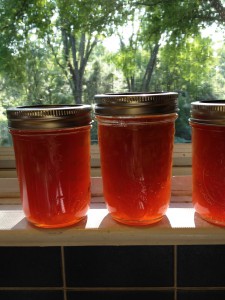 I remember my mother and grandmother canning every year. My grandmother would put up jars of peach halves and applesauce, and my mother made strawberry jam. It always seemed like a silly waste of time to me, since you can buy all those things in a store. But canning is a thing now, and on a whim I decided to try it a couple years ago. One batch of strawberry jam and I was hooked. I can’t explain it, but there is something extraordinarily satisfying about hearing the ping of jars sealing because then you know you’ve done it right.
I remember my mother and grandmother canning every year. My grandmother would put up jars of peach halves and applesauce, and my mother made strawberry jam. It always seemed like a silly waste of time to me, since you can buy all those things in a store. But canning is a thing now, and on a whim I decided to try it a couple years ago. One batch of strawberry jam and I was hooked. I can’t explain it, but there is something extraordinarily satisfying about hearing the ping of jars sealing because then you know you’ve done it right.
But canning is a high energy activity. There are several places in the process where you can’t stop for a break. The boiling water in the canner heats up the kitchen. Many recipes require constant stirring. I always dissolved into a puddle on the floor after a canning session. The day I turned 50 pounds of tomatoes into 13 quarts of tomato sauce comes to mind as an example of the insanity.
When I started using the heart rate monitor, canning was one of many hobbies that seemed completely incompatible with this new way of pacing. Certainly my old way of canning is now impossible. But could I adapt the process to be more heart rate friendly? My husband bought a peck of peaches at our local farmer’s market, so I decided to give it a shot. Here’s what happened:
- Gather equipment (canner, funnel, tongs) and wash jam jars. Move very slowly so you don’t set of the heart rate monitor.
- Sit down for 10 minutes.
- Blanch peaches.
- Sit down for 5 minutes.
- Peel peaches and chop. Mix peaches with lemon juice and hope they won’t turn brown while you rest.
- Lie down for 15 minutes.
- Drink a large glass of water.
- Drag chair over to stove so you can sit while you stir the jam. Make jam.
- Wonder how sick women managed to survive on the frontier. Decide that they didn’t.
- Remove jars from boiling water. Wonder why no one has invented a better jar lifter that makes you less likely to scald yourself.
- Fill jars with jam. Quietly exult that there is one half-jar of jam that will have to be consumed immediately.
- Add lids and move jars back to the canner.
- Drink a large glass of water. Resist the burning urge to do all the dishes. Lie down for 10 minutes instead.
- After jars have boiled for 10 minutes, remove lid and turn off heat. Start the dishes.
- After 5 minutes, remove jars from the canner and wait for that lovely PING! as the lids seal. Finish the dishes.
- Collapse on the couch.
- Test jam on a piece of toast.
- Wonder how you got a splatter of jam on the back of your tshirt.
- Admire your lovely jars of jam.
Did taking rest breaks make it easier? Yes. My heart rate monitor went off a couple times, but never for very long and the highest it went was 100 beats per minute. I was still exhausted at the end of the process, but I don’t think it was quite as bad as previous canning sessions. That may just be wishful thinking since I don’t have hard data from past years for comparison. My pre-heart rate monitor canning would have taken 1.5 hours. Adding in the rest breaks extended it to 2.25 hours.
I think I’ll pat myself on the back for giving this a try. Rather than assume that this hobby is off limits because of the way I used to do it, I tried to adapt it to my limitations. It’s bittersweet because I was happy to be doing it, but also frustrated that I couldn’t work as fast as I did before. It would be easier if I could recruit help (anyone want to wash my dishes?). And I doubt I’ll be tackling monster projects like 13 quarts of tomato sauce. But I’m really proud of my peach jam, and it will taste better for the effort that went into it.


I love your attitude! It’s finding ways to do the things we enjoy that is important. (And learning which to give up also.)
Last year I put up about 100 – 120 jars of jams, chutneys, tomato sauces and so on… and also grew all the fruit and veg. This year I made a single batch of red &blackcurrant jam and did it very much as you did…. right down to this step here: “Wonder how sick women managed to survive on the frontier. Decide that they didn’t.” LOL
I’m currently trying to NOT give up doing agility with my little dog, and am trying to teach her to understand words and gesticulations… with varying degrees of success. But hey we’re having such fun doing badly….. (I have given up walking them to exercise them however… sadly.)
I’m sure your peach jam was scrummy. 🙂
Yes! Yes! Yes!
What a brilliant example of the power of pacing. Many congratulations indeed.
I think I would have left the dishes for another time though…
Rests of any kind and especially flat rests really do help. Before I re-learned about flat rests I cleaned my garage by doing this over a period of days. by using my lanyard timer.
Alas, I’m having to do it again, as I’ve had to move things in there during construction work. I’m resisting moving things to a storage unit, but am wondering if that might be the final option after getting rid of a lot of stuff.
The trouble can be that we are clever, and driven and find it very difficult to be clever and driven in ways that support one’s body. Learning that what worked for me in most of my life does no longer work due to CFS is an on-going lesson for me.
Adapting what we we want to do to our limitations is a great phrase and perception. I shall borrow it.
Thank you.
PS Sally have you tried clicker training to reinforce your agility work?
Yup.. clickers are good…. and lots of little cubes of cheese! 😉